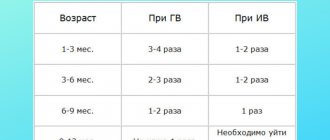What is the volume of a newborn's stomach?
It’s incredible, but the volume of a newly born baby’s stomach is less than 7 ml. That is, the size of the organ can be compared to a thimble, which can hold no more than a teaspoon of milk. On the first day of a child’s life, the mucous walls of the stomach are dense and inelastic; they are simply not able to accept large amounts of food.
If a newborn eats too much, then he still has to regurgitate the excess milk. But there is no need to worry that the child’s body receives few useful substances: the mother’s mammary glands during the first few days produce colostrum, a highly nutritious and easily digestible substance. The child grows at a rapid pace: after three days the volume of the stomach is 30 ml, after a week - 80 ml, and by the end of the month - almost 150 ml.
How to establish breastfeeding so that the newborn has enough milk?
To avoid the need to count the amount of milk consumed, it is necessary to properly establish breastfeeding. Don't worry if your baby latches on to the breast too often. This does not mean that he constantly wants to eat. Thus, the baby can also satisfy its psychological needs: to be close to its mother. It is imperative to give your baby breastfeeding at night. During these hours, the production of hormones responsible for breastfeeding occurs, so night and morning feedings are considered the most important.
A healthy baby who has just been born cannot be hungry if he has constant access to the breast. You don't need to pump to check your milk supply. The child will eat as often as he needs and will never eat too much. Therefore, there is absolutely no need to worry about this.
How much should a newborn baby eat in the first three days of life?
The feeding procedure in women who have given birth for the first time causes panic. This is not surprising, because advice from medical manuals often turns out to be inapplicable in practice. Young mothers should not worry: calculating the amount of milk for newborn babies is not as difficult as it seems.
Babies who cannot yet make active sucking movements with their mouths absorb a small amount of food from the breast, but a few drops of nourishing and nutritious colostrum are enough for them.
Since the stomach of a newborn on the first day of life is not able to accept no more than 8 ml of milk per feeding, and the daily portion of food is 100 ml, mothers need to breastfeed at least 12 times. On the second day, the amount of colostrum consumed increases to 250 ml, and on the third – to 350 ml.
Natural feeding after childbirth and in the first month of life
As a rule, active production of breast milk in the female body begins only on the 4th day after birth, although the baby is brought to the mother for the first feeding already on the 2nd day (sometimes on the 1st day). At the same time, many young mothers worry that they cannot yet provide as much milk as the baby should eat. In fact, there is no need to be nervous about this for several reasons:
- The baby’s sucking reflex has not yet fully developed, so he simply cannot suck out a lot at once.
- From the 1st to the 5th day, the female body produces colostrum - milk containing antibodies that will become the child’s first defense against all kinds of diseases. Colostrum is high in fat and nutritional content, so the child should not eat as much of it as regular milk.
- A baby's stomach, several days old, is still very small and cannot hold more than 10 ml. colostrum. Therefore, as a rule, a newborn does not consume more than 8-9 ml.
- At 1 month of age, babies are fed up to 12 times a day, so they eat as much food as they need for their growth.
- Immediately after childbirth, mothers are advised to avoid nerves, since worries can lead to a later onset of lactation.
At 1 month of age, the baby should be actively growing and eating more and more milk every day. After all, the further activity of its development will depend on how much food it receives during this period. Therefore, at 1 month the baby needs to be fed abundantly and often. So the feeding standards for the first 10 days of a child’s life are as follows:
- Day 2 – the amount of colostrum consumed is about 20 g at a time. The baby eats up to 250 g per day;
- Day 3 – newborns can consume up to 30 g of milk. Consequently, the volume of food consumed reaches 350-360 g;
- 4th day - the child is already able to eat 40 g of milk per feeding, etc.
As you can see, the milk supply is steadily increasing by 10 g, and this continues throughout the first ten days of 1 month of life. Therefore, in order to determine how much food a newborn should consume, simply multiply the number of days of his life by 10.
In order to find out exactly how much food the baby ate at one feeding, you can use the old and proven method - weighing. To do this, it is enough to weigh the newborn before eating and immediately after it. By determining the dose that a child sucks at one time and checking the current standards, you can accurately understand whether he is receiving as many nutrients as he should at his age.
After the first ten days of the first month of feeding, the increase in the volume of milk secreted will stop. From then on, the amount of food consumed will be approximately 1/5 of the total body weight of the newborn. At the same time, experts are convinced that feeding should not be carried out at specific periods of time. On the contrary, the baby needs to eat at the moment when he wants it. In the first months of life, the frequency of feedings can reach up to 12, and the interval between them can be about one and a half to two hours. The duration of one procedure sometimes reaches 40 minutes (usually up to half an hour), after which children stop actively sucking. Although, even despite the completion of feeding, the baby may not let go of the breast (either he receives leftover food, or he simply enjoys the process). However, you should not keep it on your chest for more than 60 minutes.
Professionals have long calculated the nutritional standards that a baby should receive in the first year of his life. We present them in the table below.
| Baby's age | Milk consumed per 1 feeding, ml | Milk consumed per day, ml |
| 3-4 days | 20-60 | 200-300 |
| 1 week | 50-80 | 400 |
| 2 weeks | 60-90 | 1/5 by weight |
| 1 month | 100-110 | 600 |
| 2 months | 120-150 | 800 |
| 3 months | 150-180 | 1/6 mass |
| 4 months | 180-210 | |
| 5-6 months | 210-240 | 800 ml – 1 l. |
| 7-12 months | 1/8-1/9 mass |
How much formula should a newborn eat?
Just as with natural feeding, the baby needs to eat at least ten times a day, and the volume of artificial formula consumed should be the same as breast milk. If the baby does not want to eat often, then the portion of the mixture can be slightly increased. You should not overfeed your baby, even if he has a good appetite. The table shows the recommended daily servings of artificial formula:
How to calculate the daily amount of breast milk according to Maslov
Soviet pediatrician Maslov developed a caloric method for determining the amount of milk needed by a newborn baby. To make the correct calculation, you need to know the exact weight of the baby. A liter of breast milk contains about 700 kilocalories. One kilogram of a child’s body weight per day needs the following amount of energy:
- up to three months of life – 125 kcal;
- from three to six months – 120 kcal;
- from six to nine months – 110 kcal;
- from nine months to one year – 100 kcal.
To calculate the daily portion of milk, you need to multiply the number of kilocalories by the baby's weight. For example, a two-month-old baby weighs 6 kg. It turns out: 125 kcal × 6 kg = 750 kcal. In this case, the child needs to consume a little more than half a liter of breast milk per day.
How to tell if your newborn baby is getting enough food
The most reliable indicator of a child’s adequate nutrition is a steadily increasing body weight and length. Every month the baby must be weighed at the clinic. Upon examination, the pediatrician determines whether the baby is malnourished or, conversely, eats too much in a day. The table below gives the normal weight gain for a child from birth to one year.
The table shows the average data; if the baby’s weight deviates slightly from the norm, then there is nothing to worry about. But if body weight differs too much from the table values, then most likely the child is starving or, conversely, overeating. In this case, you should definitely consult a pediatrician.
Video:
How to determine if your baby has enough milk:
Should you breastfeed by the hour or on demand?
How does a baby eat in the first 24 hours of life:
While in the maternity hospital, the young mother's constant assistants are nurses and doctors who give advice on proper feeding and care for the newborn baby. When leaving the maternity hospital, most, even experienced women, are faced with problems of proper distribution of breast milk during breastfeeding, so that the baby does not suffer from a lack or excess of food.
Medical specialists made calculations and determined the optimal amount of food a child should eat by month, as well as the required frequency of breastfeeding. One of the main indicators of proper feeding is weight gain. These indicators are informed during routine medical examinations or patronage.
Feeding volume up to 1 month
After the baby is born, the nurse or midwife must bring it to the mother's breast for the first attachment. There is no breast milk during this period, but the produced colostrum provides the newborn’s body with essential nutrients.
On the 2nd day after birth, the baby begins to show signs of hunger every 3 hours. Each application to the breast, according to the amount of food eaten, ranges from 10 to 20 ml. A baby can eat up to 100 ml per day.
On the 3rd day after childbirth, breast milk production increases significantly in a nursing woman. By this time, the child has fully mastered the technique of sucking the breast, and the amount of food eaten increases. On average, a baby can eat from 120 to 180 ml per day, or about 30 ml at a time.
By the end of the first week after birth, the baby can eat from 50 to 70 ml per breastfeeding. The daily volume in this case is up to 400 ml. For 2 weeks, the baby consumes up to 500 ml of milk per day.
When the baby is one month old, the normal indicators are the frequency of attachments from 6 to 8 per day, and the amount of breast milk consumed is 90-100 per attachment to the breast.
Of course, this statistics is generalized, and the indicators can be individual for each newborn.
Peculiarities of nutrition of a baby on guard duty
Breastfeeding is a natural process established by nature, the next stage in a child’s life cycle, which helps a newborn more easily get used to a new environment and adapt to a new world. The baby's sucking reflex operates on a subconscious level, but for full breastfeeding it needs to be developed, and the baby needs to be taught how to latch onto the breast correctly. This is why young mothers have questions about the satiety of their babies, because new skills are not always easy for a newborn.
First feeding experience
Colostrum is much more valuable in its nutritional properties than further milk. The protective functions of the immune system and overall health directly depend on the beneficial substances that colostrum contains. These first drops serve as the basis for good health and full development of the baby in the future.
It is simply impossible to eat more colostrum than needed; at first, no more than 8 ml of liquid is available to the baby per feeding. That is, during the first day the newborn eats only 100 ml. Each new day gives the baby and mother new strength, so daily nutritional intake increases by an average of 10 grams.
Nutritional intake for a newborn from 2 to 4 days of life
| Amount of days | Portion of milk per feeding | Daily norm |
| 2 | 20 ml | 210 – 230 ml |
| 3 | 30 ml | 300 ml |
| 4 | 40 ml | 400 ml |
You can also carry out a mathematical calculation of the norm for one feeding. It looks like the usual equation x*10=ml, where x is the day of the baby’s life. It turns out that if you need to find out the norm for a baby five days old, then 5 is multiplied by 10, and it turns out that the baby should eat 50 ml at one feeding.
Recommended feeding rate for a baby from 2 weeks of life to one year
| Baby's age | Portion of milk per feeding | Daily norm |
| 2 weeks | 60 - 90 ml | 20% of the child's total weight |
| Month | up to 110 ml | 600 ml |
| 2 months | up to 150 ml | 800 ml |
| 3 months | up to 180 ml | one sixth of the baby's total weight |
| 4 months | up to 210 ml | one sixth of the baby's total weight |
| Up to six months | up to 240 ml | one-seventh of the child's total weight |
| 7 – 12 months | up to 240 ml | up to 1/9 of the child’s total weight |
How to determine how much milk he should eat based on his baby's weight
It’s good when the exact numbers are known, but some mothers find it difficult to answer how much their baby ate. The easiest way to find out the required number is by weighing the baby both before and after feeding. The result obtained is the number of grams that the baby ate. To calculate the norm per day, a similar procedure must be carried out with each feeding for the entire 24 hours. In this way, the norm is calculated for both artificial babies and infants.
A child’s weight can often unnecessarily upset a young mother. In addition to them, it is worth focusing on the general condition of the child.
How long should a baby be at the breast?
Today's breastfeeding standards dictate that the baby should suckle for about 40 minutes at each feeding, with a break of two or three hours. These are maximum indicators, but the baby can empty the breast on his own earlier, so 20 minutes is also not considered a bad indicator if at the same time the baby is gaining weight and actively growing. But a longer stay at the breast indicates that the baby most likely uses the breast more for comfort, as a nipple. It is better not to allow such behavior in a newborn, since over time it will not bring anything good other than inconvenience.
Amount of nutrition for 6-12 months
From 6 months to the first year of life, the baby should eat from 170 to 250 ml of milk or formula once a day. During this period, 1 or 2 feedings are replaced with complementary feeding products (porridge, purees, juices).
If the child is on artificial nutrition, then the required amount of the finished formula can be found on the baby food packaging. Manufacturers of formulas indicate in detail the volume of dry formula and liquid required for preparing ready-made food, as well as the rate of its consumption for children of different ages.
How much should a baby eat at 1 month?
The standards of pediatricians of the last century prescribed that by the age of one month a baby must absorb up to 900 grams of mother's milk or formula. Given the different weights at which a baby is born, all newborns have their own nutritional needs.
Unfortunately, not all babies are breastfed. Many people are forced to eat formula from the first days of life. Some newborns have a mixed feeding pattern. Therefore, knowing the rules of feeding is the main problem of parents, how to calculate the optimal amount of food for each feeding. The determining factors for calculation are body weight and age in days.
In the first days of his life, a newborn eats a small portion. The stomach is so small that it is not able to absorb more than 20 ml of food. But by the tenth day, the growing body is able to absorb more food. The stomach is growing, and a newborn can easily eat 80-90 ml per feeding.
Important! If the baby is breastfed, he does not need additional water. He satisfies all fluid needs with his mother's milk. If he wants to eat or drink, the breast is enough for him.
Ready-made formulas are very different in composition from breastfeeding. The baby needs some water. Pediatricians recommend the amount of water per day - the volume of one feeding. If the baby has gained weight of about 3800 grams by the month of life, he needs up to 100 ml of additional liquid per day to the milk formula.
Child drinks water
How to Determine Nutritional Adequacy
Knowing the required amount of food consumed according to age, each woman can use techniques to determine nutritional adequacy. To determine, it is recommended to use the following tips:
- Pumping before feeding. The accuracy of this method remains in doubt, but it can be used to determine the approximate volume of breast milk consumed. It is recommended to express carefully and thoroughly, immediately before feeding. Even the right approach cannot ensure complete emptying of the mammary glands. During normal breastfeeding, the baby eats 15-20 ml more than the expressed volume. This is important to take into account when making calculations.
- Using household scales. To determine the amount of food eaten, it is necessary to weigh the baby before feeding and immediately after feeding. The difference in weight will be equal to the amount of food eaten. Before weighing, the child must be completely undressed and freed from diapers and nappies, which may cause excess weight.
- The behavior of a baby can tell a lot. If the newborn is calm, cries occasionally, is not capricious, is friendly, and gains weight according to age and normal, then we can say with confidence that he is receiving enough food.
How to solve the problem of malnutrition
If for some reason the newborn does not receive the proper amount of food, then his behavior speaks for itself. When malnourished, children become capricious, whiny and irritable. In addition, poor weight gain is a reliable indicator of malnutrition.
You can solve the problem of malnutrition with the following tips:
- Increasing the frequency of breastfeeding. This method is very effective and allows you to solve the problem of malnutrition in a matter of days. Increasing the frequency of feedings stimulates milk production, thereby providing the baby with the necessary volume.
- The minimum duration of feeding should be at least 20-25 minutes. Artificially shortening the duration often leads to malnutrition.
- Increasing the volume of fluid you drink. We are talking about a nursing woman who must consume at least 2 liters of fluid daily to ensure normal lactation.
- A nursing woman is not recommended to artificially increase the fat content of breast milk by consuming fatty foods. These actions will not contribute to the speedy saturation of the baby during feeding.
- Only a pediatrician can determine the required amount of food, taking into account the individual characteristics of the child.
Baby feeding regimen
The type of feeding and how many times the baby eats per day are dependent variables. If a child receives artificial milk formula, he eats at intervals of 31/2 hours during the day. At night the break is up to 5-6 hours.
Newborn hat size
When a mother feeds her baby breast milk on demand, he receives much more food than formula-fed babies. You need to take into account that a boy at 1 month suckles more intensively. But children should not be put to the breast all the time. The minimum acceptable interval for maternal feeding is 2.5 hours.
On average, in 24 hours the number of applications ranges from 10 to 12 times. The timing of the “eating” itself is also different. Baby formula from a bottle is eaten faster, the baby needs a maximum of 5-10 minutes. Breastfeeding lasts longer. Babies often feed for up to 40 minutes.
Features of breastfeeding
It’s not for nothing that mother’s milk is called the best food for newborn babies in the first month. It is completely absorbed by the small organism, ensuring growth, development and immunity from disease. Regardless of the climate in which the parents and the baby live, he does not require any other food to exist and grow, except milk.
If the child's weighing indicates insufficient weight gain, possible reasons:
- insufficiency of breastfeeding;
- duration of 1 feeding is less than 15 minutes;
- the baby needs help learning to hold the nipple correctly;
- possible malaise, consultation with a pediatrician is required;
- low calorie diet for mom.
Important! According to the recommendations of pediatricians, newborns should be put to the breast immediately after birth. This serves as a stimulus for milk production and increases the rate of uterine contractions.
Colostrum is healthy; it contains elements necessary to protect against infection. The correct posture of mother and child is of great importance:
- the baby is completely turned towards the mother;
- maximum proximity between them;
- The child eats calmly, he is relaxed and does not knock his legs.
Pacifiers should not be given between breastfeedings. The baby's movements and efforts vary greatly with different feeding methods. The baby may ask for the breast less often, which will reduce the supply of mother's milk.
How much milk does a newborn need?
Every day the baby needs more and more nutrition. In the first ten days, the amount of food that the baby is able to absorb increases by 10 ml per feeding.
Average indicators of how much milk a one-month-old baby should eat and need
| Days of life | Norm for 1 feeding (g.) | Daily volume (ml) |
| 1 day | To 10 | Up to 100 |
| Day 2 | 20 | 200-240 |
| Day 2 | 30 | 300-340 |
| 7 days | 50-80 | 400 |
| 14 days | 60-90 | 20% of weight |
| 30 days | 100-110 | 600 |
Peculiarities of feeding with artificial formula The observant mother herself evaluates how much the baby drinks in order to measure the volume of breast milk during the day.
Formula feeding
When forced to switch to breast milk substitutes, the main task is to choose the right formula. A children's product must be highly adaptable. Healthy one-month-old infants should have in their diet a mixture marked “1”; they are called units.
It is not uncommon for a nursing mother to experience a decrease in breast milk production. There is no need to immediately try to feed the baby with artificial formula. First, you should take all measures and follow recommendations to increase lactation. To do this, pediatricians advise:
- increase the number of breastfeedings;
- ensure skin-to-skin contact between mother and baby;
- For a nursing mother, calm down and don’t panic.
Simple measures have good effectiveness; in many cases, mothers only breastfeed for a long time.
How to calculate the amount of mixture
You can find out how much formula a child should eat in 1 day to 1 month in different ways. When artificial feeding, it is important not to overdo it with the volume of the mixture. The child must be well-fed, then he develops normally and gains weight. When calculating the dose for 1 feeding, the age (in days), weight of the child and the number of feedings per day are taken into account. Breaks between feedings during the daytime - from 2.5 hours, at night - no more than 6 hours.
Feeding bottle with spoon
Do not insist if the child has not drunk the entire bottle. There are two options: invite the baby to finish the meal within an hour, when the mixture was diluted, or not insist, but wait for the next feeding. A hungry baby will eat the next feeding with great appetite.
Frequent crying after eating does not always mean “I’m hungry.” More often, the child experiences discomfort from air trapped during sucking. A few minutes of upright body positioning will eliminate the problem. The baby should burp slightly, the air will come out, and the pain will go away.
Upright position after feeding
The volume of the formula for the first 10 days from birth is found using the formula:
D x 10 = V (age in days multiplied by 10).
For example, if the baby is 7 days old, then 70 ml of formula is required for one feeding (7 x 10 = 70). Here weight is taken into account, the daily dose is 1/5 of the weight.










